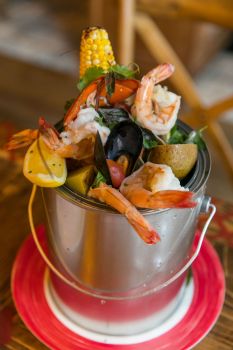For anyone who grew up in New England (and, of all places, Ohio), the clambake is a summer standard. It is a time to gather the friends and family, crack open a bunch of cold beers, and go to town on the bounty of bivalve delights found just offshore.
Clambakes originally involved grabbing the clams from their sandy homes, digging a pit, lining said pit with seaweed, adding rocks that have been heated in a fire, adding the clams, then covering with more seaweed and sad. It was an easy way to for people to prepare and consume what was at-hand without the use of cooking implements (because, in the case of the Native American tribes that first practiced clambakes, they didn’t have pots).

Over time, the clambake has evolved. More seafood was thrown in, as were vegetables and other ingredients — both to add numerous flavors and to extend the clambake if there weren’t enough clams to go around. Oh, and the addition of beer or other potent potables really helped things along (though we feel confident in saying that the first people who prepared clambakes in the Northeast would’ve been down to crack open a cold one if beer had been available then).
Much as the recipes have changed, so too have the preparation methods. Instead of using an open flame and seaweed, why not use a paint can and a grill? That is exactly what chef David Burke has done with this super easy, super tasty clambake recipe.
Burke — of Tavern62 by David Burke in New York City and BLT Prime by David Burke in Washington D.C. — takes a clean paint can (needless to say, don’t just go using whatever paint can you come across in the garage, please) and loads it up with a variety of marine goods and vegetables. From there, all you need is a grill and boom, you’ve got yourself a clambake.
Check out the recipe below and make sure you have plenty of beer on hand.
Grilled Paint Can Clambake

Serves 4
Ingredients:
- 1 to 1.25-lb lobster
- 3 to 4 medium-sized shrimp
- 6 mussels
- 6 clams
- 8 slices chorizo or spicy Italian sausage
- 2 to 3 red potatoes, diced
- 8 cloves garlic, sliced
- 1 cup chopped tomatoes
- 1 ear of corn
- .5 cup chopped basil
- 1 lemon, cut into wedges
- 5 cup white wine
- 5 to 6 tbsp butter
- 2 tbsp red pepper flakes
- 1 tbsp Old Bay seasoning
- Salt and pepper
Method:
- In a large, empty paint can, place the lobster, followed by the rest of the ingredients, saving the shrimp to go in last for the top.
- Cover with foil and place on the grill. Cook over medium heat until the foil begins to puff about, shellfish open, and potatoes are tender (about 25 minutes).
- Serve with lots and lots of grilled bread.



